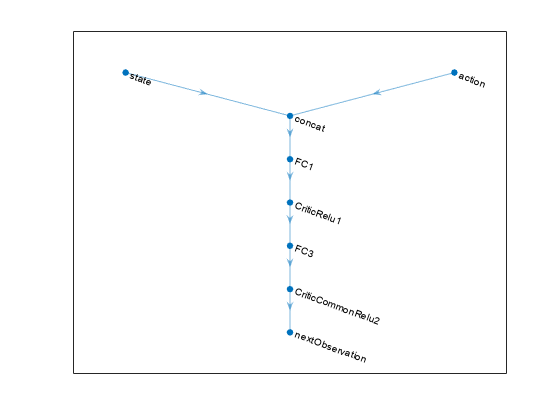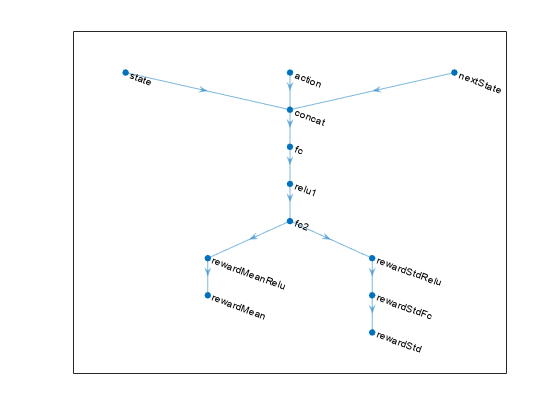rlNeuralNetworkEnvironment
Description
Use an rlNeuralNetworkEnvironment object to create a
reinforcement learning environment that computes state transitions using deep neural
networks.
Using an rlNeuralNetworkEnvironment object you can:
Create an internal environment model for a model-based policy optimization (MBPO) agent.
Create an environment for training other types of reinforcement learning agents. You can identify the state-transition network using experimental or simulated data.
Such environments can compute environment rewards and termination conditions using deep neural networks or custom functions.
Creation
Syntax
Description
env = rlNeuralNetworkEnvironment(ObservationInfo,ActionInfo,transitionFcn,rewardFcn,isDoneFcn)ObservationInfo and ActionInfo,
respectively. This syntax sets the TransitionFcn,
RewardFcn, and IsDoneFcn properties.
Input Arguments
This property is read-only.
Observation specifications, specified as an rlNumericSpec
object or an array of such objects. Each element in the array defines the properties
of an environment observation channel, such as its dimensions, data type, and name.
You can extract the observation specifications from an existing environment or
agent using getObservationInfo. You can also construct the specifications manually
using rlNumericSpec.
Action specifications, specified as an rlFiniteSetSpec
or rlNumericSpec
object. This object defines the properties of the environment action channel, such as
its dimensions, data type, and name.
Note
For the neural network environment, only one action channel is allowed.
You can extract the action specifications from an existing environment or agent
using getActionInfo. You can also construct the specification manually using
rlFiniteSetSpec
or rlNumericSpec.
Properties
Environment transition function, specified as one of the following:
rlContinuousDeterministicTransitionFunctionobject — Use this option when you expect the environment transitions to be deterministic.rlContinuousGaussianTransitionFunctionobject — Use this option when you expect the environment transitions to be stochastic.Vector of transition objects — Use multiple transition models for an MBPO agent.
Environment reward function, specified as one of the following:
rlContinuousDeterministicRewardFunctionobject — Use this option when you do not know a ground-truth reward signal for your environment and you expect the reward signal to be deterministic.rlContinuousGaussianRewardFunctionobject — Use this option when you do not know a ground-truth reward signal for your environment and you expect the reward signal to be stochastic.Function handle — Use this option when you know a ground-truth reward signal for your environment. When you use an
rlNeuralNetworkEnvironmentobject to create anrlMBPOAgentobject, the custom reward function must return a batch of rewards given a batch of inputs.
Environment is-done function, specified as one of the following:
rlIsDoneFunctionobject — Use this option when you do not know a ground-truth termination signal for your environment.Function handle — Use this option when you know a ground-truth termination signal for your environment. When you use an
rlNeuralNetworkEnvironmentobject to create anrlMBPOAgentobject, the custom is-done function must return a batch of termination signals given a batch of inputs.
Observation values, specified as a cell array with length equal to the number of
specification objects in ObservationInfo. The order of the
observations in Observation must match the order in
ObservationInfo. Also, the dimensions of each element of the cell
array must match the dimensions of the corresponding observation specification in
ObservationInfo.
To evaluate whether the transition models are well-trained, you can manually
evaluate the environment for a given observation value using the
step function. Specify the observation values before calling
step.
When you use this neural network environment object within an MBPO agent, this property is ignored.
Transition model index, specified as a positive integer.
To evaluate whether the transition models are well-trained, you can manually
evaluate the environment for a given observation value using the
step function. To select which transition model in
TransitionFcn to evaluate, specify the transition model index
before calling step.
When you use this neural network environment object within an MBPO agent, this property is ignored.
Object Functions
rlMBPOAgent | Model-based policy optimization (MBPO) reinforcement learning agent |
Examples
Create an environment object and extract observation and action specifications. Alternatively, you can create specifications using rlNumericSpec and rlFiniteSetSpec. These are going to be the observation and action specification objects for your environment.
env = rlPredefinedEnv("CartPole-Continuous");
obsInfo = getObservationInfo(env);
actInfo = getActionInfo(env);Get the dimension of the observation and action spaces.
nObs = obsInfo.Dimension(1); nAct = actInfo.Dimension(1);
Create a deterministic transition function based on a deep neural network with two input channels (current observations and actions) and one output channel (predicted next observation).
% Create network layers. statePath = featureInputLayer(nObs, ... Normalization="none",Name="state"); actionPath = featureInputLayer(nAct, ... Normalization="none",Name="action"); commonPath = [concatenationLayer(1,2,Name="concat") fullyConnectedLayer(64,Name="FC1") reluLayer(Name="CriticRelu1") fullyConnectedLayer(64, Name="FC3") reluLayer(Name="CriticCommonRelu2") fullyConnectedLayer(nObs,Name="nextObservation") ]; % Create dlnetwork object and add layers transitionNetwork = dlnetwork(); transitionNetwork = addLayers(transitionNetwork,statePath); transitionNetwork = addLayers(transitionNetwork,actionPath); transitionNetwork = addLayers(transitionNetwork,commonPath); % Connect layers transitionNetwork = connectLayers( ... transitionNetwork,"state","concat/in1"); transitionNetwork = connectLayers( ... transitionNetwork,"action","concat/in2"); % Plot network plot(transitionNetwork)

% Initialize dlnetwork object. transitionNetwork = initialize(transitionNetwork); % Create transition function object. transitionFcn = rlContinuousDeterministicTransitionFunction(... transitionNetwork,obsInfo,actInfo,... ObservationInputNames="state", ... ActionInputNames="action", ... NextObservationOutputNames="nextObservation");
Create a deterministic reward approximator object with two input channels (current action and next observations) and one output channel (predicted reward value).
% Create network layers. nextStatePath = featureInputLayer( ... nObs,Name="nextState"); commonPath = [concatenationLayer(1,3,Name="concat") fullyConnectedLayer(32,Name="fc") reluLayer(Name="relu1") fullyConnectedLayer(32,Name="fc2")]; meanPath = [reluLayer(Name="rewardMeanRelu") fullyConnectedLayer(1,Name="rewardMean")]; stdPath = [reluLayer(Name="rewardStdRelu") fullyConnectedLayer(1,Name="rewardStdFc") softplusLayer(Name="rewardStd")]; % Assemble dlnetwork object. rewardNetwork = dlnetwork(); rewardNetwork = addLayers(rewardNetwork,statePath); rewardNetwork = addLayers(rewardNetwork,actionPath); rewardNetwork = addLayers(rewardNetwork,nextStatePath); rewardNetwork = addLayers(rewardNetwork,commonPath); rewardNetwork = addLayers(rewardNetwork,meanPath); rewardNetwork = addLayers(rewardNetwork,stdPath); % Connect layers rewardNetwork = connectLayers( ... rewardNetwork,"nextState","concat/in1"); rewardNetwork = connectLayers( ... rewardNetwork,"action","concat/in2"); rewardNetwork = connectLayers( ... rewardNetwork,"state","concat/in3"); rewardNetwork = connectLayers( ... rewardNetwork,"fc2","rewardMeanRelu"); rewardNetwork = connectLayers( ... rewardNetwork,"fc2","rewardStdRelu"); % Plot network plot(rewardNetwork)

% Initialize dlnetwork object and display the number of parameters
rewardNetwork = initialize(rewardNetwork);
summary(rewardNetwork) Initialized: true
Number of learnables: 1.4k
Inputs:
1 'state' 4 features
2 'action' 1 features
3 'nextState' 4 features
% Create reward function object. rewardFcn = rlContinuousGaussianRewardFunction(... rewardNetwork,obsInfo,actInfo,... ObservationInputNames="state",... ActionInputNames="action", ... NextObservationInputNames="nextState", ... RewardMeanOutputNames="rewardMean", ... RewardStandardDeviationOutputNames="rewardStd");
Create an is-done function approximator object with one input channel (next observations) and one output channel (predicted termination signal).
% Create network layers. isDoneNetwork = [ featureInputLayer(nObs,Name="nextState"); fullyConnectedLayer(64,Name="FC1") reluLayer(Name="CriticRelu1") fullyConnectedLayer(64,Name="FC3") reluLayer(Name="CriticCommonRelu2") fullyConnectedLayer(2,Name="isdone0") softmaxLayer(Name="isdone") ]; % Create dlnetwork object. isDoneNetwork = dlnetwork(isDoneNetwork); % Initialize network and display the number of weights isDoneNetwork = initialize(isDoneNetwork); % Create is-done function approximator object. isDoneFcn = rlIsDoneFunction(isDoneNetwork, ... obsInfo,actInfo, ... NextObservationInputNames="nextState");
Create a neural network environment using the transition, reward, and is-done function approximator objects.
env = rlNeuralNetworkEnvironment( ... obsInfo,actInfo, ... transitionFcn,rewardFcn,isDoneFcn)
env =
rlNeuralNetworkEnvironment with properties:
TransitionFcn: [1×1 rl.function.rlContinuousDeterministicTransitionFunction]
RewardFcn: [1×1 rl.function.rlContinuousGaussianRewardFunction]
IsDoneFcn: [1×1 rl.function.rlIsDoneFunction]
Observation: {[4×1 double]}
TransitionModelNum: 1
To check the environment, you can also call its reset and step functions.
obs0 = reset(env);
obs0{1}ans = 4×1
103 ×
-0.8472
5.1832
8.7759
6.2140
[xn,rn,id]=step(env,{rand(nAct,1)})xn = 1×1 cell array
{4×1 single}
rn = single
410.7173
id = 0
You can use your neural network environment as an internal model for a model based reinforcement learning agent, such as rlMBPOAgent.
Create an environment object and extract observation and action specifications. Alternatively, you can create specifications using rlNumericSpec and rlFiniteSetSpec. These are going to be the observation and action specification objects for your environment.
env = rlPredefinedEnv("CartPole-Continuous");
obsInfo = getObservationInfo(env);
nObs = obsInfo.Dimension(1);
actInfo = getActionInfo(env);
nAct = actInfo.Dimension(1);Create a deterministic transition function approximator based on a deep neural network with two input channels (current observations and actions) and one output channel (predicted next observation).
% Create network layers. statePath = featureInputLayer(nObs, Name="obsInLyr"); actionPath = featureInputLayer(nAct, Name="actInLyr"); commonPath = [ concatenationLayer(1,2,Name="concat") fullyConnectedLayer(64) reluLayer fullyConnectedLayer(64) reluLayer fullyConnectedLayer(nObs,Name="nextObsOutLyr") ]; % Assemble dlnetwork object and connect layers. trnsNet = dlnetwork(); trnsNet = addLayers(trnsNet,statePath); trnsNet = addLayers(trnsNet,actionPath); trnsNet = addLayers(trnsNet,commonPath); trnsNet = connectLayers(trnsNet,"obsInLyr","concat/in1"); trnsNet = connectLayers(trnsNet,"actInLyr","concat/in2"); % Plot network. plot(trnsNet)

% Initialize network and display the number of weights.
trnsNet = initialize(trnsNet);
summary(trnsNet) Initialized: true
Number of learnables: 4.8k
Inputs:
1 'obsInLyr' 4 features
2 'actInLyr' 1 features
% Create transition function approximator object. transitionFcn = rlContinuousDeterministicTransitionFunction(... trnsNet,obsInfo,actInfo,... ObservationInputNames="obsInLyr", ... ActionInputNames="actInLyr", ... NextObservationOutputNames="nextObsOutLyr");
You can define a known reward approximator for your environment using a custom function. Your custom reward approximator must take the observations, actions, and next observations as cell-array inputs and return a scalar reward value. For this example, use the following custom reward function, which computes the reward based on the next observation.
type cartPoleRewardFunction.mfunction reward = cartPoleRewardFunction(obs,action,nextObs)
% Compute reward value based on the next observation.
if iscell(nextObs)
nextObs = nextObs{1};
end
% Distance at which to fail the episode
xThreshold = 2.4;
% Reward each time step the cart-pole is balanced
rewardForNotFalling = 1;
% Penalty when the cart-pole fails to balance
penaltyForFalling = -50;
x = nextObs(1,:);
distReward = 1 - abs(x)/xThreshold;
isDone = cartPoleIsDoneFunction(obs,action,nextObs);
reward = zeros(size(isDone));
reward(logical(isDone)) = penaltyForFalling;
reward(~logical(isDone)) = ...
0.5 * rewardForNotFalling + 0.5 * distReward(~logical(isDone));
end
You can define a known is-done approximator for your environment using a custom function. Your custom is-done function must take the observations, actions, and next observations as cell-array inputs and return a logical termination signal. For this example, use the following custom is-done function, which computes the termination signal based on the next observation.
type cartPoleIsDoneFunction.mfunction isDone = cartPoleIsDoneFunction(obs,action,nextObs)
% Compute termination signal based on next observation.
if iscell(nextObs)
nextObs = nextObs{1};
end
% Angle at which to fail the episode
thetaThresholdRadians = 12 * pi/180;
% Distance at which to fail the episode
xThreshold = 2.4;
x = nextObs(1,:);
theta = nextObs(3,:);
isDone = abs(x) > xThreshold | abs(theta) > thetaThresholdRadians;
end
Create a neural network environment using the transition function object and the custom reward and is-done functions.
env = rlNeuralNetworkEnvironment(obsInfo,actInfo,transitionFcn,...
@cartPoleRewardFunction,@cartPoleIsDoneFunction)env =
rlNeuralNetworkEnvironment with properties:
TransitionFcn: [1×1 rl.function.rlContinuousDeterministicTransitionFunction]
RewardFcn: @cartPoleRewardFunction
IsDoneFcn: @cartPoleIsDoneFunction
Observation: {[4×1 double]}
TransitionModelNum: 1
To check the environment, you can also call its reset and step functions.
obs0 = reset(env);
obs0{1}ans = 4×1
103 ×
-8.0681
6.9177
8.1879
-9.7732
[xn,rn,id]=step(env,{rand(nAct,1)})xn = 1×1 cell array
{4×1 single}
rn = -50
id = logical
1
You can use your neural network environment as an internal model for a model based reinforcement learning agent, such as rlMBPOAgent.
Version History
Introduced in R2022a
See Also
Functions
Objects
MATLAB Command
You clicked a link that corresponds to this MATLAB command:
Run the command by entering it in the MATLAB Command Window. Web browsers do not support MATLAB commands.
Sélectionner un site web
Choisissez un site web pour accéder au contenu traduit dans votre langue (lorsqu'il est disponible) et voir les événements et les offres locales. D’après votre position, nous vous recommandons de sélectionner la région suivante : .
Vous pouvez également sélectionner un site web dans la liste suivante :
Comment optimiser les performances du site
Pour optimiser les performances du site, sélectionnez la région Chine (en chinois ou en anglais). Les sites de MathWorks pour les autres pays ne sont pas optimisés pour les visites provenant de votre région.
Amériques
- América Latina (Español)
- Canada (English)
- United States (English)
Europe
- Belgium (English)
- Denmark (English)
- Deutschland (Deutsch)
- España (Español)
- Finland (English)
- France (Français)
- Ireland (English)
- Italia (Italiano)
- Luxembourg (English)
- Netherlands (English)
- Norway (English)
- Österreich (Deutsch)
- Portugal (English)
- Sweden (English)
- Switzerland
- United Kingdom (English)